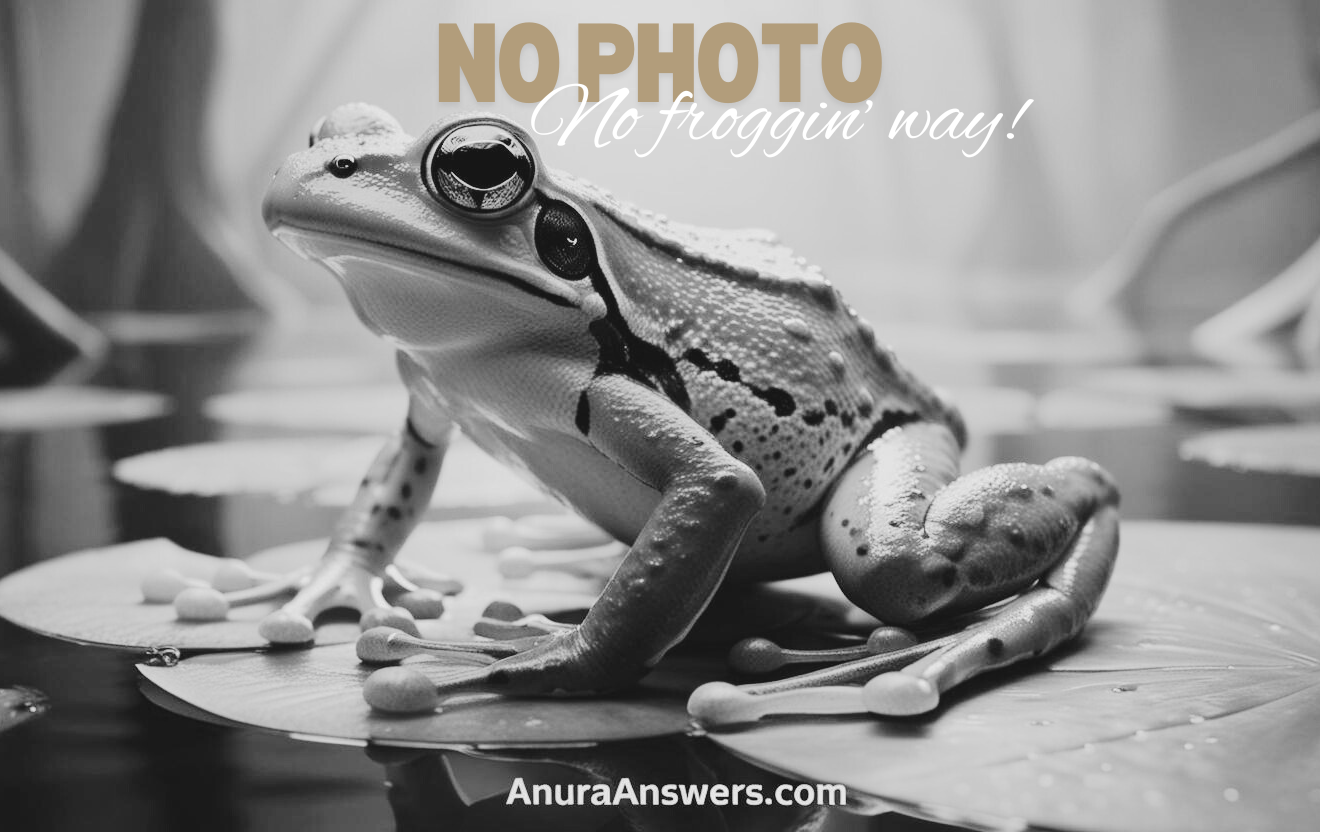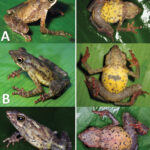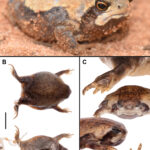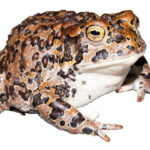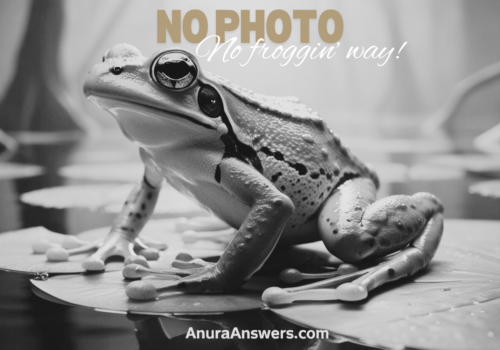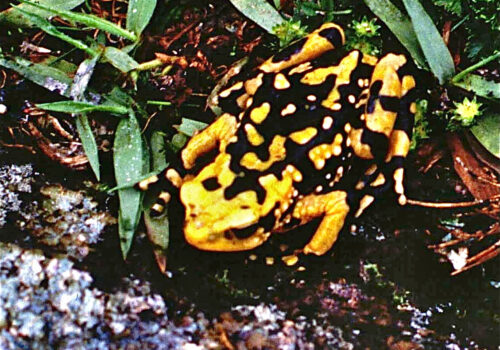- Atelopus petriruizi: Discovering Colombia’s Resilient Harlequin Toad
- Taxonomy and Classification
- Natural Habitat: The Cloudy Refuge of Colombia’s Andes
- Physical Characteristics: Dressed to Impress, Built for Survival
- Behavior and Life Cycle: An Amphibious Life Captivating the Curious
- Ecological Role: A Small Creature with a Big Impact
- Threats and Conservation Status: A Jewel Amidst Growing Pressures
- Cultural and Scientific Significance: Beyond Biological Importance
- Conclusion: Embracing the Responsibility to Act
Atelopus petriruizi: Discovering Colombia’s Resilient Harlequin Toad#
Among the lush, softly drenched forests that cloak the western slopes of Colombia’s Andes mountains, a tiny jewel of a creature hides in plain sight. Bursting with musterous mottles and brilliant splashes of color, the Atelopus petriruizi—commonly known as Ruiz’s Harlequin Toad—is a creature whose charm belies a perilous conservation story. Known scientifically as Atelopus petriruizi, this wondrous amphibian embodies both nature’s remarkable artistry and the urgent challenges facing biodiversity conservation today.
But what’s truly fascinating—and perhaps bittersweet—about Ruiz’s Harlequin Toad is its ability to amaze even amid adversity. Despite facing threats that could have easily silenced its vibrant calls, the toad persists, offering researchers and conservationists rare glimpses into its enigmatic world.
Taxonomy and Classification#
The Ruiz’s Harlequin Toad, Atelopus petriruizi, belongs to the family Bufonidae—a family encompassing perhaps the most iconic amphibians around the world: the true toads. Within this family, the genus Atelopus is renowned for its dazzling diversity and striking coloration, giving rise to their common name “Harlequin Toads.”
This Colombian endemic species was classified scientifically by José Vicente Rueda-Almonacid and Jorge Velásquez-Álvarez in 2008, honoring the late Colombian conservationist Pedro Miguel Ruiz-Carranza. Researchers consider it closely related to other participating species of the Andean foothills—each adapted to their unique habitat niches and microclimates.
Natural Habitat: The Cloudy Refuge of Colombia’s Andes#
Nestled within the humid montane forests of Colombia—particularly in the departments of Caldas and Antioquia—the Atelopus petriruizi has evolved to shelter within a narrow band of elevation, roughly between 1,500 and 2,500 meters above sea level. Here, the perpetual mist from low-set clouds casts an ethereal atmosphere over tangled undergrowth and rushing mountain streams, a landscape conjured straight from a naturalist’s imagination.
The key elements of its habitat include pristine, rapidly flowing streams and rivers flanked by dense moss-covered stones and thick leafy vegetation. This landscape provides vital moisture and abundant resources to sustain its delicate amphibious lifestyle. Crucially, the cool, cloud-enshrouded forests maintain a stable humidity regime essential for the toad’s permeable skin and breeding requirements.
Indeed, the intimate relationship between the toad and this ecosystem highlights their delicate balance. Habitat preferences include dense leaf litter, mossy vegetation, hidden undertones, and stream banks shaded by the thick canopies of tall emergent trees. Such microhabitats offer vital protection from predators, intense sunlight, and harsh environmental changes.
Physical Characteristics: Dressed to Impress, Built for Survival#
At first glance, Atelopus petriruizi impresses with striking visuals: a small-sized amphibian averaging about 3 to 4 centimeters in body length, bedecked in a rich blend of coloration that varies from slate black or dark brown to stunning yellows, oranges, greens, and gold patterns. These contrasting hues swirl and mingle across its body in irregular patterns, making each individual unique—nature’s very own fingerprint design.
A slim, agile frame supports its terrestrial habits. Long, slender limbs equipped with delicate yet strong digits allow it to navigate the various terrains and vegetation zones comfortably. Unlike many toads, the Atelopus genus—including Atelopus petriruizi—tend toward smoother skin, with fewer pronounced warts or glands. Yet, under that velvet-soft skin lies a defense mechanism critical to their survival, an arsenal of alkaloid toxins potent enough to deter most predators.
Such coloration is not merely ornamental. Like other brightly colored amphibians, this vivid coloration acts as an aposematic signal—a natural billboard signaling danger to potential predators. Birds, reptiles, or mammals tempted by an easy meal must heed this cautionary mark or meet unpalatable consequences. Such adaptations, born of evolutionary pressure, demonstrate the delicate yet finely tuned interplay linking predator and prey across Colombia’s rich ecosystems.
Behavior and Life Cycle: An Amphibious Life Captivating the Curious#
Understanding Ruiz’s Harlequin Toad demands appreciation of their mysterious daily behaviors pulsing beneath dense foliage or at the water’s edge. Active by day (diurnal), these amphibians forage close to their home streams, preying opportunistically upon ants, beetles, mites, small spiders, and other invertebrates abundant on the forest floor.
The life cycle of Atelopus petriruizi reflects meticulous timing and coordination dictated by local climates. Typically, the rainy seasons catalyze complex, ritualistic mating behaviors where males gather close to swift-running streams, vying vigorously for optimal calling spots. Here, amid the gentle cacophony of the forests’ shifting sounds, the males emit a distinctive, melodic call—an earnest serenade designed to attract receptive females.
When the females arrive—distinctively larger and more subtly colored than their male counterparts—they choose their partners and promptly begin laying strands of gelatinous eggs hidden among damp rocks or submerged vegetation. These eggs incubate quickly, swiftly evolving into tiny, fish-like tadpoles.
The ensuing tadpole stage is aquatic, primarily designed for swift and efficient progression to metamorphosis. Within weeks or months, depending on ambient temperature and habitat quality, these tiny, wriggling beings sprout limbs and emerge as miniature versions of their adults, completing a captivating and well-adapted cycle essential for the perpetuation of the species.
Ecological Role: A Small Creature with a Big Impact#
Small as it may be, Ruiz’s Harlequin Toad serves a vital ecological role in its delicate forest habitats. As both a predator and prey species, the toad’s ecological niche holds together a complex food web. By consuming small insects and arachnids, it controls insect populations that otherwise might become overabundant, mitigating harmful impacts such as crop pests or plant harm.
Furthermore, as prey itself, Atelopus petriruizi significantly supports higher-order predators in the ecosystems, such as snakes, small mammals, and certain bird species. This amphibian also shines as an indicator species, serving as a biological sentinel whose health and population fluctuations reflect subtle or not-so-subtle shifts in environmental quality.
Threats and Conservation Status: A Jewel Amidst Growing Pressures#
Sadly, despite its resilience and beauty, Atelopus petriruizi faces urgent conservation threats. Like many amphibians worldwide, their adaptive strategies are increasingly tested by phenomena such as climate change, habitat destruction, and the devastating amphibian chytrid fungus, Batrachochytrium dendrobatidis, a pathogen causing severe population declines and extinction events in amphibians globally.
The International Union for Conservation of Nature (IUCN) currently classifies Atelopus petriruizi as Critically Endangered, underscoring a perilous fragility. Rapid habitat loss, driven by deforestation and agricultural expansion in Colombia’s Andean slopes, compounds pressures on this species. Coupled with pollution and changes in water quality, survival becomes increasingly challenging.
Thankfully, various scientific and conservation organizations in Colombia conduct active field studies, awareness campaigns, and protective efforts to safeguard these unique amphibians. Through localized conservation strategies, habitat protection initiatives, and captive breeding programs, hope thrives—albeit tenuously—for Ruiz’s Harlequin Toad’s continued survival.
Cultural and Scientific Significance: Beyond Biological Importance#
Beyond ecological importance, Atelopus petriruizi holds profound cultural resonance within Colombian communities. The local Indigenous and rural communities often recognize these harlequin toads as symbols of ecological balance and natural harmony. They feature prominently in local folklore and are historically intertwined with regional identity narratives highlighting deep-rooted respect for biodiversity.
Furthermore, scientifically, research surrounding this species enriches global understanding of amphibian chemical biology, disease resistance, climate change adaptation, and complex ecosystem interactions—indeed, much more than mere beauty-caressing forest shadows.
Conclusion: Embracing the Responsibility to Act#
In the tapestry woven by the clouds and streams of Colombia’s misty Andes, Atelopus petriruizi glimmers with fragile determination. This tiny yet powerful emblem of ecological wonder shines a stark light onto the myriad dangers confronting amphibians and biodiversity. While admiring its artistic skin patterns, melodic calls, or life’s magical transformations, we must remember our shared responsibility to conserve and cherish their hidden realms.
Let Ruiz’s Harlequin Toad become a beacon of ecological consciousness, urging each of us to appreciate, protect, and advocate for nature in its precious, irreplaceable fullness.
